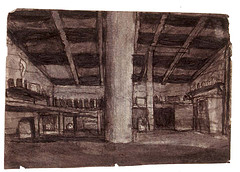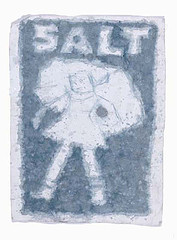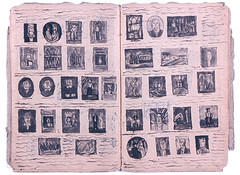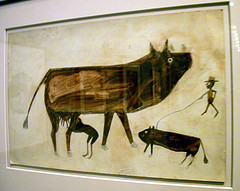[Ed. Note: This post has been corrected. Two names were wrong, Sister Gertrude Morgan (not Morris) and Bill Traylor (not James). Sorry for the mistakes.]
[This week’s Weekly has my story about the new Philadelphia philanthropy, the Self-Taught American Artists Foundation created by Jill and Sheldon Bonovitz. Here’s the link to the art page and below is the copy with some pictures. Click the images to see them bigger.]
Castle in the Clouds
An art-collecting couple spreads the word of self-taught artists.

James Castle’s command of perspective is amazing given that he had no art lessons.
There’s no stopping an art collector whose passion to educate is as strong as his passion to collect. Take Albert Barnes and the Barnes Foundation. Or Sheldon and Jill Bonovitz, who collect art by self-taught artists like James Castle, Howard Finster and Elijah Pierce. The Bonovitzes incorporate the work of these artists in their own home and in the collection at the offices of
Duane Morris LLP, where Sheldon is CEO. But two years ago the couple created the Foundation for Self-Taught American Artists (Foundation STAART) to make, archive and disseminate films about self-taught American artists in order to educate the public about these artists.

The cardboard here is from a box, flattened but used over every inch of its surface.
I met with the Bonovitzes and the Foundation’s new executive director Molly Dougherty to find out more about the Foundation and its first film project—a documentary about the life and art of James Castle, the deaf mute artist from Boise, Idaho.
The Castle film is now in production, with New York filmmaker Jeffrey Wolf directing. Wolf, a Foundation trustee, is a natural choice for this project as he’s also a passionate collector of art by self-taught artists. John Ollman, director of Fleisher-Ollman Gallery (which has long specialized in art by self-taught artists), is also one of the Foundation’s 10 trustees.It was Ollman who nudged the Castle project along: After a trip to Idaho he reported back that Castle family members were aging and so the time to start shooting the documentary was now.

Morton salt done by James Castle.
Also nudging the project along is the exhibition on Castle’s art coming to the Philadelphia Museum of Art in the fall of 2008. The documentary will be on view as part of that exhibit, organized by the PMA’s Prints and Drawings Department curator Ann Percy.
Wolf—a film director and editor who’s collaborated with John Waters, Ted Demme, Jonathan Demme, Arthur Penn and others—began the film in one four-day shoot on location in Idaho and then edited it into a short for the PMA’s exhibit. The plan is to also produce features of varying lengths for educational purposes.
The nonprofit STAART Foundation isn’t only about making films. The bigger goal is education. And toward that end another priority is to make existing film footage about self-taught artists available to educational institutions.

Castle made some constructions from cardboard stitched together with string.
“There’s a tremendous amount of film footage that exists,” Sheldon says, noting that many collectors venture out to visit the artists, bringing their movie cameras with them and making films that are like labors of love. “We’ll collect, edit and package it for schools. If an institution wants it, we’ll make it available.”
Jill says one goal—albeit a long-range one—is to make a film about several artists and get it into wide distribution at independent film festivals or on public television. Meanwhile, depending on how things turn out, it could be that the Castle film will make it into wider distribution.
The Bonovitzes believe scholarship about self-taught artists belongs in the mainstream of art history, and that discussion of those artists is generally missing from the art story most people know.

Example of one of the books Castle made.
While they’re happy there’s a separate museum devoted to the work of self-taught artists—the American Folk Art Museum in New York (whose Contemporary Center director Brooke Anderson is also on the STAART advisory board)—the Bonovitzes are happier still with the PMA’s approach to mainstreaming the self-taught artists’ art, something evident right now in the Energy Yes! Installation in the Contemporary Art gallery, where curator Carlos Basualdo has placed work by self-taught artist Martin Ramirez alongside that of art insiders like Joseph Beuys, Bruce Nauman and Andy Warhol.
[Ed note: I asked Basualdo about being a trustee for the foundation. Unfortunately because he was travelling his email response came too late for his quote to be incorporated in this article but through the miracle of artblog and our ample space for extra text, I’m including it here:
“I am happy to serve in the Board of the Foundation, mostly because I truly believe that those artists should be regarded within the largest context of modern and contemporary art, and surely the Foundation will help tremedously with that,” said Basualdo.]
“I think most colleges that teach art should teach about the self-taughts,” he says, adding that there’s a double-standard in contemporary art education that includes some artists like Basquiat and Joseph Cornell, but excludes others like Traylor, Elijah Pierce and Sister Gertrude Morgan.

Here’s a Bill Traylor piece that was in a New Acquisitions show at the PMA a little while ago.
I asked them about fundraising at a time when Philadelphia art institutions like the PMA and the Barnes are struggling to raise money for their expansions. “We’re very careful to not go to the same sources the the PMA goes to. We don’t want to be impinging on them,” says Sheldon.
Dougherty says the Foundation—a supporting organization of the PMA, but with its own funding and budget—is working on a website to make information about the artists available to anyone whose interested. Even the movies will be online, similar to how they are at the art brut website.
The Bonovitzes believe stories of artists like James Castle, who was handicapped, or Bill Traylor, who was born a slave, have the power to uplift and transform students’ lives by proving genius can grow in nontraditional places. For more on the Bonovitz collection see my Weekly article from Jan. 5, 2005.
For more information about the Foundation for Self-Taught American Artists, call 215.979.1155









